Compiled by Roger Bateman with the added reminiscences of Gerald (Gerry) White.
Advertisements from some of the town’s shops and businesses ranging from the early 1900’s to the 1950’s. Largely a pictorial record including brief information where known to which has been added extracts from the recollections of Gerry Impey. Gerry has become a much valued contributor to the Shorehambysea.com history forums with his knowledge of the town over many years from the 1930’s onwards.
Battens Dairies c.1930
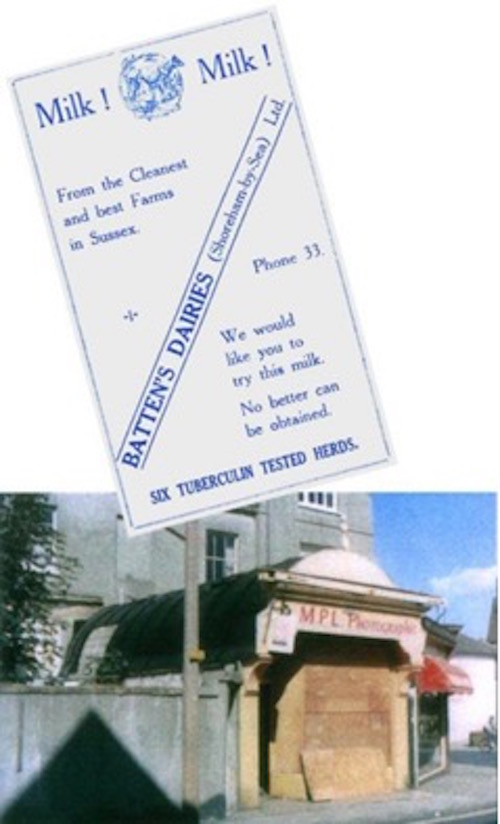
The dairy was housed in the old ‘Vinery’ (a rare Georgian iron and glass walkway or porch to the house behind) on the corner of St.Mary’s Road with Brunswick Road. It is seen here still showing the fascia lettering of the photographic business that was in it shortly before its removal in 1989. The advert says ‘We would like you to try this milk’ – did they provide free samples then?
“It was a very noisy place with its metal crates and glass bottles when they were being moved around. A long term employee of Batten’s was early riser Bill Norris. Known as ‘Paddy’ to his family and friends he was always polite, would never stop work but always give a cheery wave or nod to anyone passing the dairy. He could be seen working in the milk parlour where he scalded the returned bottles, refilled them with fresh milk, sealed the tops with a small cardboard disc then placed them in the crates. Each delivery man would then load the crates into the floats that were parked in Brunswick Road.
Bill was a diminutive figure and wore a rubber apron but despite his small size would hurl the crates across the eternally wet floor of the dairy. He kept that floor scrupulously clean and all spilt milk was immediately sluiced away to the drains. In those days almost every household took a milk delivery and Battens was the most well known of all the Shoreham dairies.” – Gerry
John Brown c.1900 /Ellman Brown c.1930
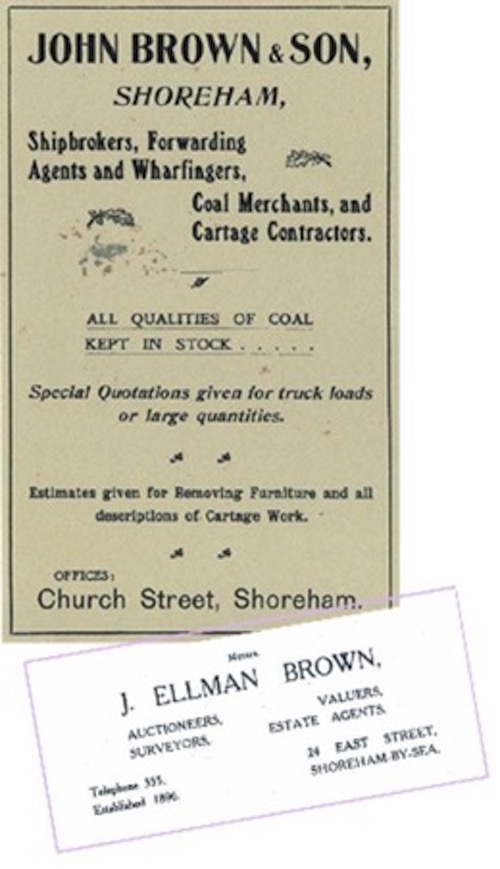
John Brown, a 19th century shipbroker and coal merchant, was a well known figure in Shoreham who originally lived at, and ran his business from, 18 Church Street before moving to Buckingham Road but keeping the former as his office.
His son, John Ellman Brown a property dealer who had his business in East Street, was perhaps even more illustrious becoming the Clerk to the Council, Vice Consul to five nations and High Constable of Shoreham.
“ I knew Zoe, Ellman’s wife. She lived on the Old Fort Road opposite Sue Baker, Warwick Baker’s wife. I seem to recall that at one time they also had a bungalow at Cuckoo’s Corner. Ellman Brown was a much respected business man in Shoreham and was well liked.” – Gerry
College Laundry c.1930
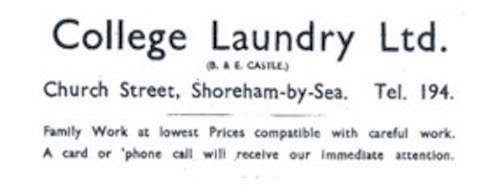
The laundry was at 24 Church Street where Woodard’s college once was. After the college was removed to Ardingly the building became the laundry for the students and masters at Lancing College. This business was subsequently extended to provide a laundry service to the public as well.
W.F.Colbourne , Butcher c.1900
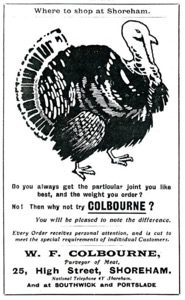
Cooks, Jam Manufacturer c. 1930
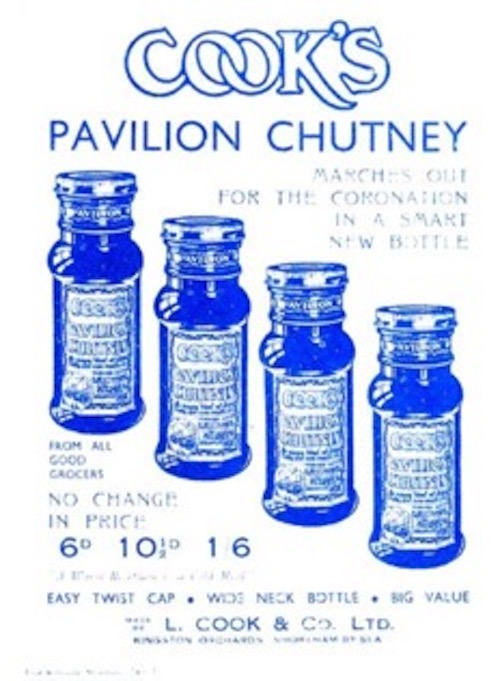
“Cooks manufactured jams and chutneys from a small factory on Dolphin Road. The smells from the production process were so pleasant and made a lovely change from the awful aromas from nearby Eversheds. The fruit was grown on the south side of Middle Road bounded by Adelaide Square, the railway line and Middle Road School. Black, red and white currants were grown there together with a range of other soft fruits such as raspberries, strawberries and gooseberries. There were also plum, apple and pear trees.
I think production ceased in the early 1950’s when some of the land was taken over by the school as a further sports field. The firm were not a big employer – I think there were less than 100 employees.” – Gerry
The Crown & Anchor c.1920
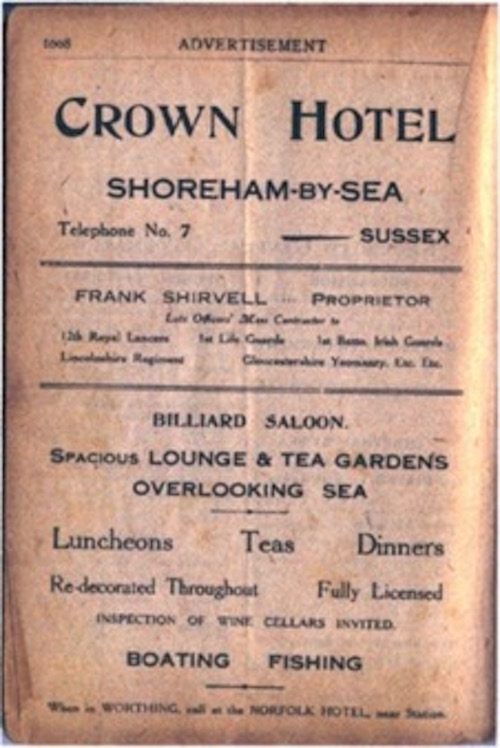
This advertisement perhaps seeks to place the Crown and Anchor above its station in life as a hotel rather than a pub. The claim that it overlooks the sea might be stretching the truth somewhat but it certainly had, and still has, excellent river views.
A. Eade & Son, Grocers c.1900 (large advertisement) and 1937
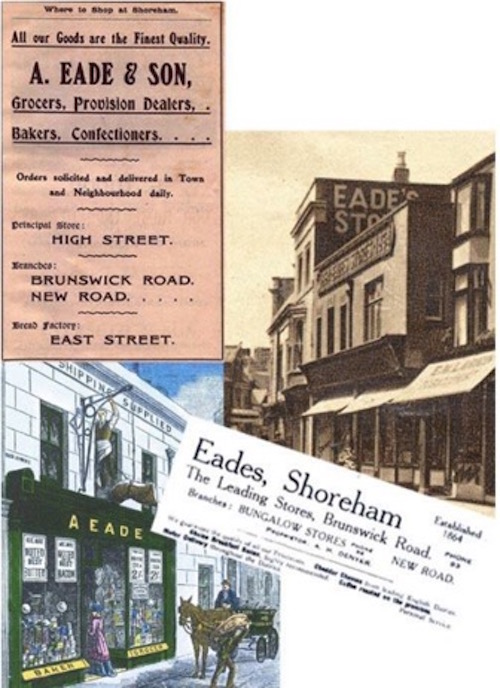
The illustration below shows Eade’s first shop at 8 High Street in 1864 before it was extended to include number 6 next door. A wall crane was used to hoist heavy provisions up to the first floor. The photograph shows it as it looked in the 1920’s. Eade’s eventually ran four shops including Brunswick Road, East Street, New Road and on the Beach in Ferry Road.
“Arthur Eade was aged 36 in 1877, he was married to Mary and had two daughters. He owned the High Street stores at 6 to 8 High Street and another in Brunswick Road adjacent to the Buckingham Arms (now an opticians). He dealt in groceries. He was a very religious man and a trustee for the Methodist Primitive Chapel in the High Street, since demolished. The business flourished into the 1950’s at the Brunswick Road shop where one of the employees I remember was Mr. John Potter who was pleased to offer a range of exclusive groceries that was normally only available in Brighton or Worthing.” – Gerry
J. Evershed & Son, Soap Manufacturer c.1900

“Eversheds were situated in Dolphin Road where they manufactured soap and related products. During the 1940’s and 50’s the stench from the production methods permeated the area of dwelling houses on the Lower Brighton Road, Corbyn Crescent and the Southlands Hospital complex. Also affected were Adelaide Square and the Middle Road Secondary Modern School with over 400 pupils.
The smell was appalling and made some people physically sick. In summer, despite the heat of the weather, all school windows were shut against the pong which nowadays would be in breach of Public Health regulations. Eversheds was a big employer of local folk who were loath to complain. I believe the firm also produced Brobat, a bleach based liquid chemical sold in bottles. My mother used it to clean our toilet and the outside drain.” – Gerry
H. G. Glasspool, Chemists c.1900
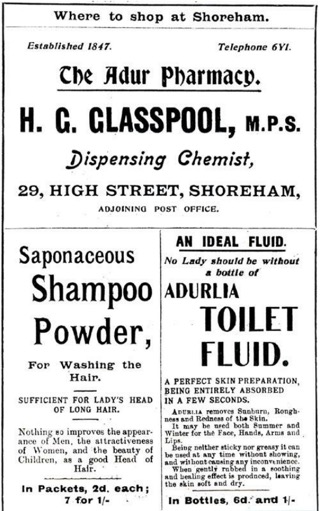
“My father told me about Glasspools of 29 High Street on the south side. He was one of the first chemists in Shoreham during the days before the National Health Service. The local chemist then was the person to whom ordinary folk turned for advice on the treatment of medical conditions and, of course, chemists were the place to take your camera for loading and unloading film for subsequent developing and printing.
Mr. Glasspool was another religious man connected with the Methodist Church in Brunswick Road. His daughter Miss E. Glasspool of Gordon Road was an employee of the Post Office which was also on the south side of the High Street, opposite the Co-op.” – Gerry
Grammar School c.1930 (blue advertisement) and c. 1900
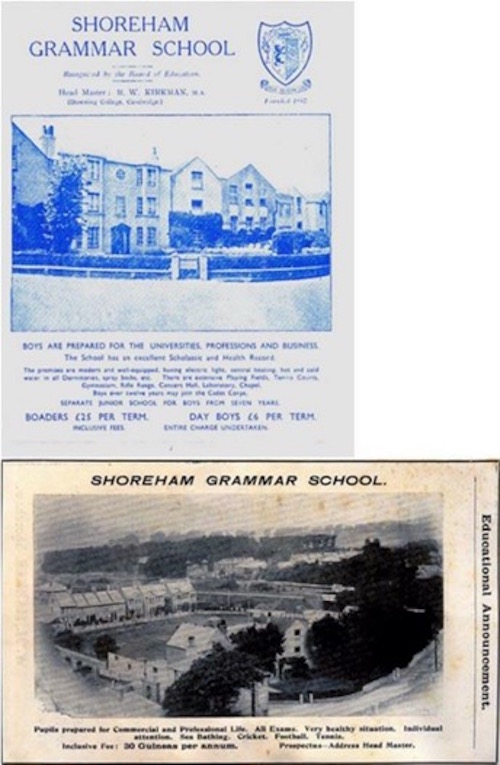
Founded by W.H.Harper in 1842 before Nathaniel Woodard started his school and college, the Grammar School was originally in East Street before moving to Pond Road. Later known as the Protestant Grammar School (in pointed opposition to Woodard’s ‘higher’ church school) it outgrew the Pond Road premises and started annexing nearby houses such as Hutchins Place (now Westover) and others. Later known as the Shoreham Grammar School it moved away in 1965 when the old Georgian buildings that once housed it were demolished and replaced by the Community Centre.
W. H. Harker, Hardware c.1900
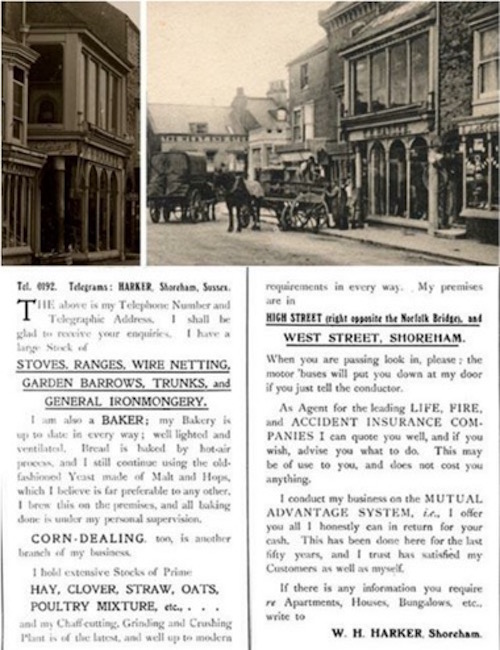
Harker’s shop figures in most of the old photos and postcards of the western end of the High Street. His hardware and corn-dealing business also utilised the tall warehouse in West Street that later became a dairy. Never one to miss a business opportunity he even made use of the large windows on the first floor to display his goods as evidenced by the iron fireplace shown in the left hand photo. His advertisement shown here also reflects his business sense and although the ‘Mutual Advantage System’ he refers to may appear to be a product of his opportunistic mind there is evidence to show that there was such a commercial method in use at the time.
“William Harker was a Justice of the Peace and I knew his son George who lived in Ravens Road – both were connected with the Methodist Church where William was a trustee. I always felt that the reason for their attachment to that church was because they liked to have their say in what went on in competition with the big hitters like John Brown, Ellman Brown, Bridger and Tingley who adhered to the mainstream Church of England at a time when the Church was listened to. The Harkers would not have been listened to.
As children about 1949 a group of local kids found an old wooden canoe ashore on the high tide line of the Adur up by the Amsterdam. It was not tied up and there were no moorings at that point. The kids played in that canoe as it appeared to be abandoned. They later tied it up to the Toll Bridge. One of George Harker’s spies had seen the event and at midnight that day Harker banged on the doors of the children concerned and insisted that the parents accompany him to untie the canoe and remove it to the river bank. He claimed it had earlier been stolen from Suter’s Yard, a place where children never played either in the yard or on the foreshore. I knew the kids concerned and was with them when the canoe was found.
Harker…..not on my list of favourite Shoreham folk.” – Gerry
London Stores, Grocers c.1900
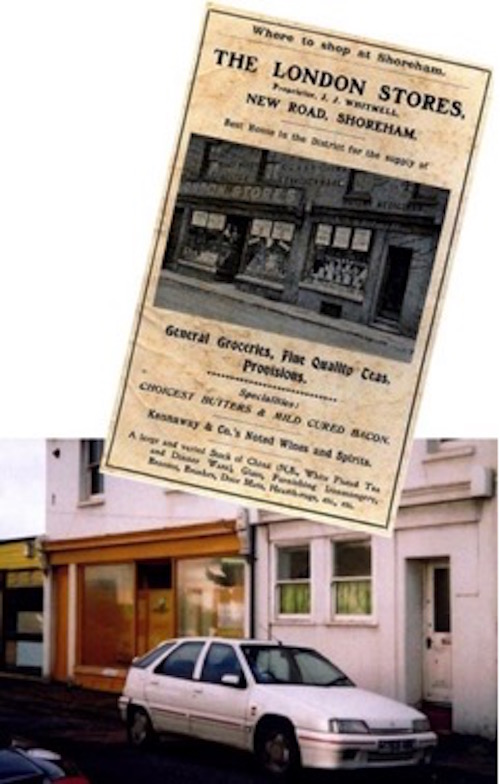
This advert shows a substantial shop which must have received a fair amount of business then from the households in Surrey and St.Aubyn’s Streets, Humphreys and Kingston Terraces as well as the eastern halves of Ham and New Roads. The photo below shows it as it is today.
H.C. Lucking, Outfitters
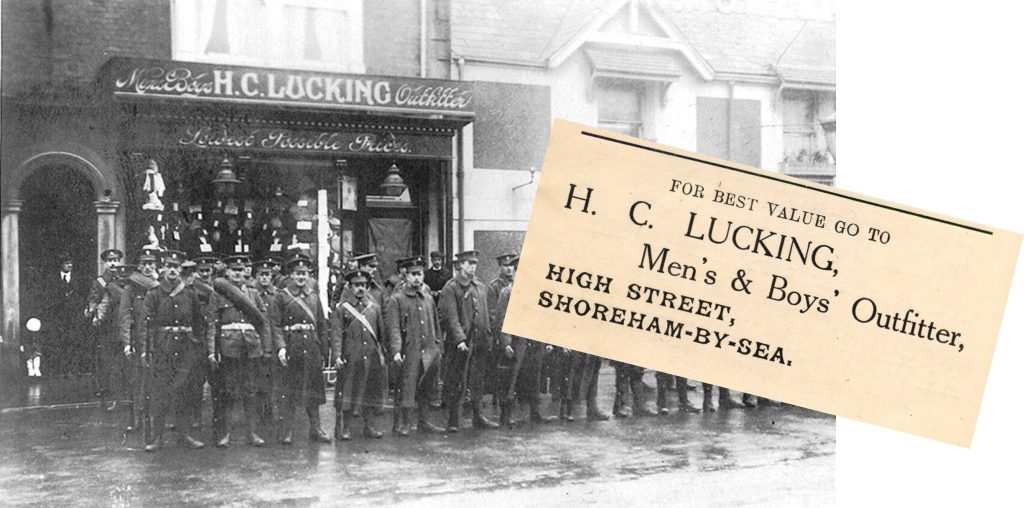
Originally in the High Street, Luckings became more well known in relatively recent years at their subsequent premises in East Street
W. Page, Photographer c.1900
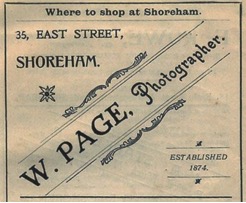
Page had one of the earliest photographer’s shops in Shoreham and many in the town had their first family portraits taken there (see wedding group photo in the article ‘Emily Hudson’). The photographic shops and photographers that followed not only provided portrait photos but, unlike William Page it seems, boosted their sales with photos and postcards of local views as well (e.g., William Winton and F.Rowe) thereby providing Shoreham with a rich record of its local history
“I didn’t know any of the photographers but every town seemed to have a number of them. Cameras were expensive, printing and developing was also costly so a visit to the photographer was often cheaper. Most had a studio and in Shoreham during the Great War were particularly busy as young soldiers liked to have a photo taken in uniform before leaving the Shoreham Training Camp for the Front.
These photographers also supplied contract pictures for the local newspapers and with the advent of flying at Shoreham Airport, the world’s oldest licensed airport, photographers would gather to photograph the aircraft in order to satisfy the public’s fascination with aircraft and flying.” – Gerry
Pope & Beesley, Printers 1951
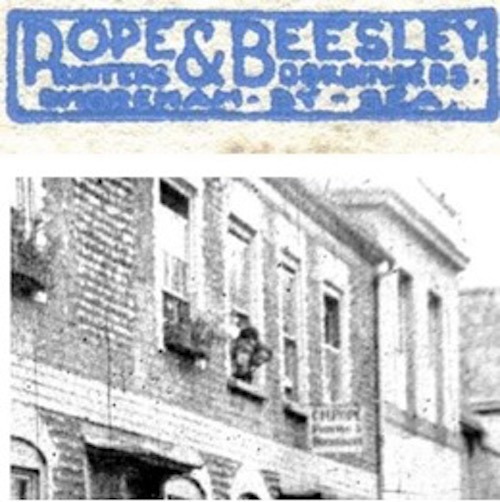
Not so much an advertisement but a rubber stamp impression of a logo from a 1951 Shoreham Pageant booklet produced by the printers Pope & Beesley. Their printing works were situated in the old chapel in Middle Street which has since been replaced by the house at number 18. One of the partners, C. H. Pope, lived at 11 Church Street and (this before entering into partnership with Beesley) rarely failed to take the opportunity for free advertising as illustrated by detail from a 1910 snapshot below which shows his flag hanging outside number 11’s window. By coincidence the picture (a ‘still’ from an old movie reel) was taken by William Winton a competitor printer whose works were in the same street but where the museum annexe is now).
“If you wanted a poster printed, raffle tickets or needed some invitation cards for that special occasion then you needed to look no further than Pope and Beesley, the printers of Middle Street in Shoreham. Very competitive in price and good quality.
I cannot recall seeing them but I used their services on a number of occasions. Their printing was carried out at premises on the west side of Middle Street down past Swan Lane. One of my school pals John Luchford started his working life as a printer’s devil (an apprentice printer) at Pope & Beesley. The last time I saw John was about 20 years ago – he was working for the Redhill Advertiser still in the printing business.” – Gerry
Rabson’s Stores 1907
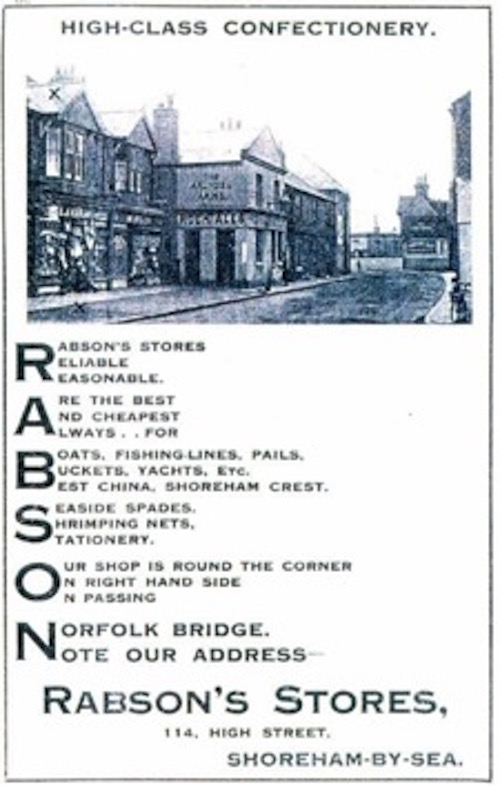
Robins Ltd, Off Licence
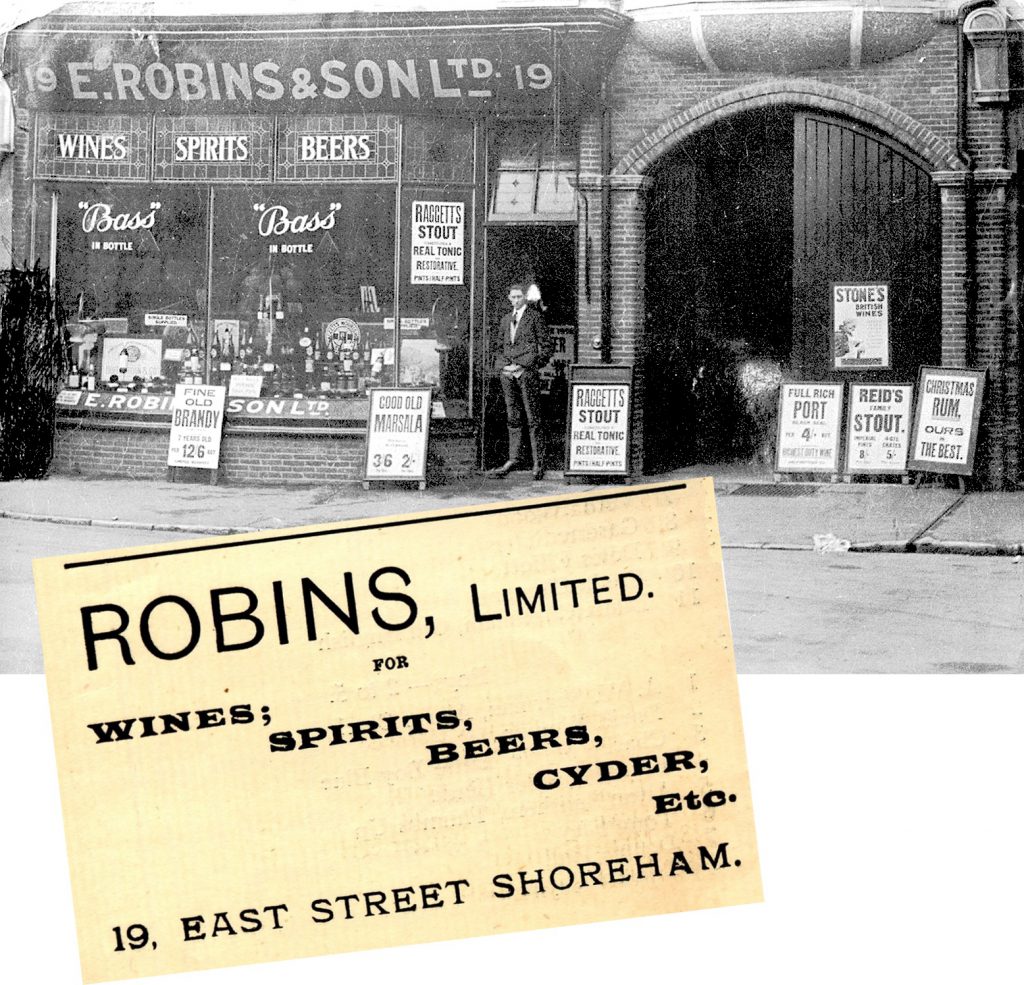
The very old houses at the south-east entrance to the churchyard were demolished during the early 1900’s and replaced by buildings that still stand today. This view is still recognisable and, out of shot to the right, was a bank that for the moment still exists.
Frank Rowe, Photographer and Newsagent c.1900
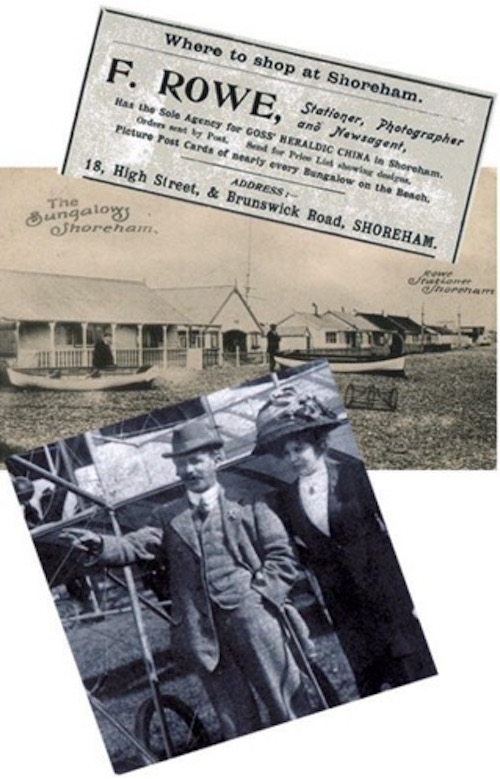
Frank Rowe was already involved with photography and flying well before WWI. The photo below shows him with his wife at the airport in front of an aircraft during 1911. At that time he ran a newsagents and photography business at 18 High Street (on the west side corner with Church Street) and another shop in Brunswick Road.
His interest in flying and skills as a photographer were put to good use during the war when he served in the Royal Flying Corps carrying out duties in reconnaissance photography
He, along with William Winton and William Page, pioneered the local post card business with many views of the town and its’ people. This Bungalow Town postcard is typical of the type he produced.
Shoreham & Lancing Land Co. Ltd., Estate Agent 1907
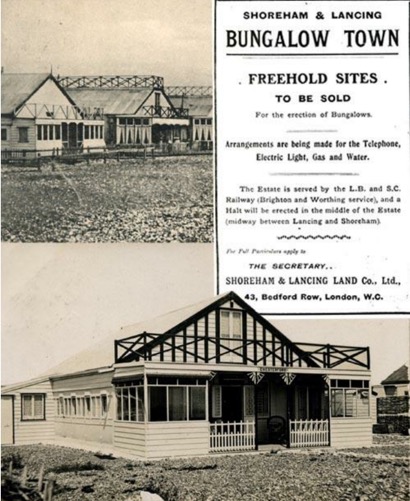
Just one of the companies set up to take advantage of the rising interest in Bungalow Town. Although selling land rather than the bungalows themselves the single bungalow shown below the advertisement is presumably included as an incentive to buy and is, of course, in pristine condition. Nevertheless, the railway carriage built into the bungalow can still be made out.
A.Snelling, Butcher
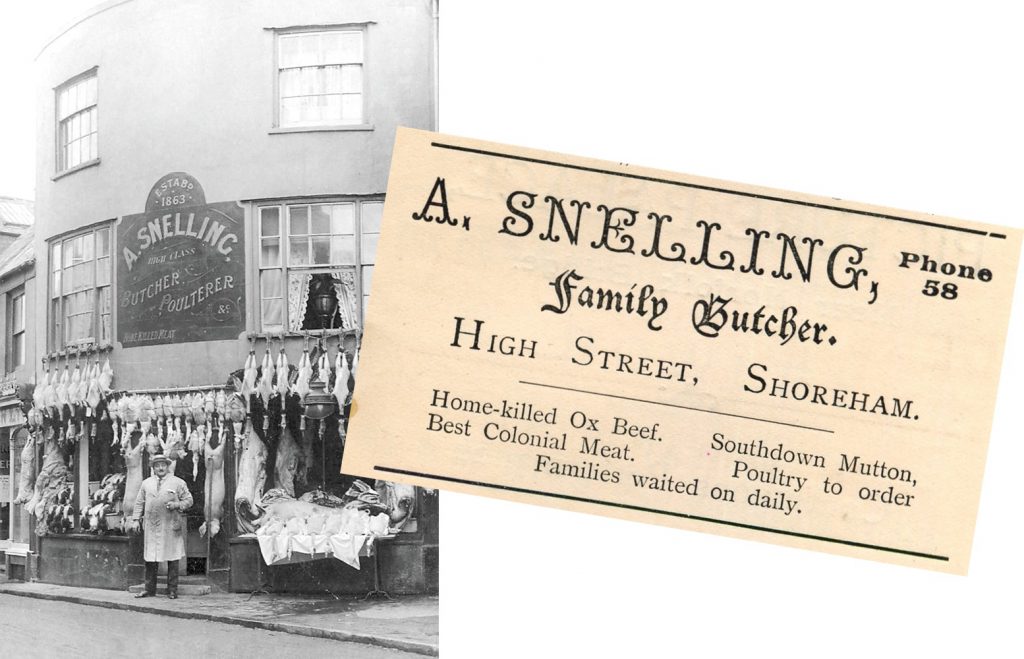
The Snelling family were well known during the first half of the 20th century. One of their first shops seen here was in the narrow gap at the east end of the High Street and was demolished during the road widenening of 1938.
Southdown Golf Club c.1900
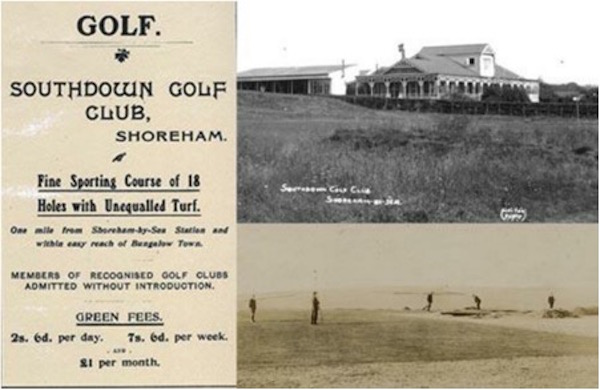
Situated on the land opposite Southlands Hospital around and beyond Buckingham Park the golf club was opened in the early 1900’s with great hopes for its future. The club house looked a little like the new bungalows on the beach in that it appears to have been made mostly of wood and this rare postcard shows a bleak vista with a green and bunkers that look to have been dug just the previous day. Nevertheless it prospered for a while and shouted its’ virtues in this early 1900’s article:-
“The Southdown Golf Club, equidistant from Shoreham and Southwick. The secretary is Mr. R. B. Dell, jun., Erringham Lodge, Shoreham. The course is eighteen holes, and the greens are large and excellent — the turf of the South Downs lending itself particularly to green play. The entrance fee and annual subscription are each three guineas. Temporary membership may be obtained on introduction by a member, and payment of 2s. a day, 10s. a week, or 10s. a month. Members of any recognised golf club, on producing evidence of such membership, are admissable at the same rates without any introduction by a member. The entrance fee and annual subscription for ladies are each three guineas. The Committee admit lady visitors at 2s.8d. a day or 7s.6d. a week. Sunday play is permitted over the whole course after 1 p.m.”
The fate of the Golf Club and the course around it is best described by Gerry:- “With the outbreak of war in 1914 Shoreham golfers said goodbye to their golf course on the downland above Southlands Hospital – it had been requisitioned by the Army and the whole course and surrounding countryside was used for military manoeuvres, training, range firing and encampments. The course had been one to rival any in Sussex and its’ merits were extolled by golf players from all over the country who came to Sussex for their holidays and sampled the local golf. An elderly Scot on holiday in Shoreham during 1981 asked me ‘Whatever happened to the wonderful golf course?” I didn’t know which is why I asked my father about it and he just said it had been a spoil of war!” – Gerry
A. E. Street, Confectioner 1907
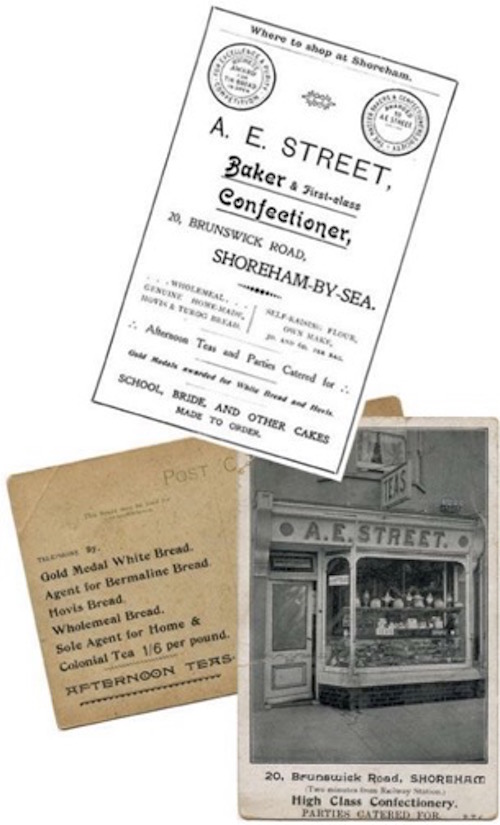
“I remember Street the confectioner it was also a cafeteria which was part of the business. They were a high class confectioners where wedding cakes and other celebratory cakes were made. The chocolate éclairs and other delicacies were always presented in white, folding boxes to protect the icing. I do believe they also catered for wedding parties and lace curtains gave privacy to the diners in the cafeteria. I knew Mrs. Barbara Edie who learned her confectionary skills from a Polish gentleman in the rooms above what is still a bakers and confectioners. The nearest rival to Streets was Spurriers on the corner of John Street.” – Gerry
Francis Suter, Yacht Builder c.1930
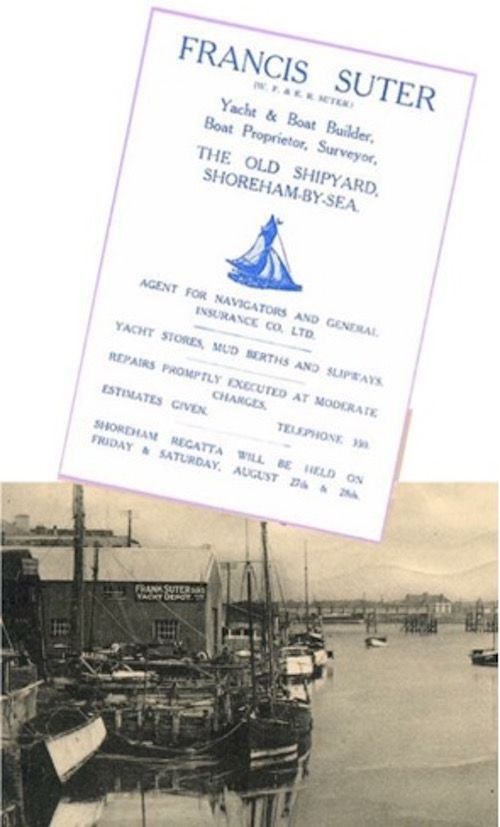
Frank (as he was generally called) Suter was the last of the better known boat builders in Shoreham carrying on as he did the tradition of the town’s centuries old industry in what was probably the oldest post medieval boatyard on the river side.
“The small boatyard on the south side of the High Street was almost adjacent to the Bridge Hotel. In the 1940’s after the war years the yard had become somewhat run down. Chestnut fencing separated the pavement from the area which was rather untidy and included a large rusted winch once used for hauling boats in or letting them into the water
Nearer the foreshore there was a large wooden, tarred shed where, I assume, the boats had been made. Small sailing craft were lying, upturned in the yard and there were a number of lobster and crab pots in a jumble. One could see it was a boat yard but well past its very best.
Frank Suter lived at 39 West Street with his parents and his three sisters one of whom I knew as Betty Foord. She had moved away from Shoreham after marrying a soldier but returned after she became widowed. The Suters were a respected family and because of the boatyard where two or three generations had worked they were well known to everyone.” – Gerry
Winton & Sons, Printers c.1900
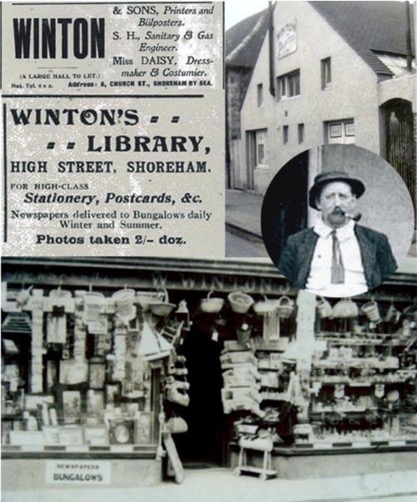
Still remembered as the man who organised Shoreham’s fetes, fairs, regattas and pageants and operated the Star Cinema during the first half of the 20th century William Winton also ran a printing works in the Middle Street building that subsequently became the Marlipins Museum annexe. William was also an adept photographer and soon realised there was profit to be made from printing postcards from photos of local views, people and events that he had taken. It is largely due to his work that we now have such a diverse record of the town’s history. The inset photo of Wiliiam suggests he was something of a character himself.
He also ran a shop in the High Street and his son (also William) later opened another in Brunswick Road.
Frederick Wood, Carter and Remover c.1900
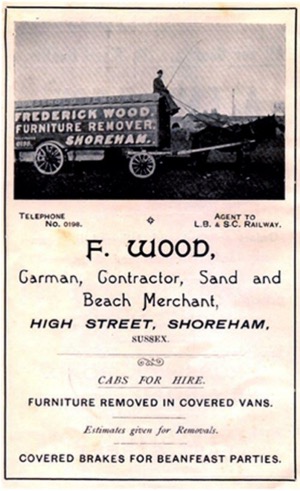
Frederick Wood was born at Kingston in 1866. The son of a corn merchant and master baker Frederick’s parents lived next to and worked for the Adams family of bakers in the High Street. He later married one of the Adams’ daughters but rather than joining the baking business started his own carting and carrying company. Wood’s carts can also be seen in some of the old photos and postcards of Shoreham
Probably the main reason for Wood’s success was his willingness to diversify his business as this advertisement indicates.
One old postcard shows his carts on the beach collecting sea-washed flints and another crossing the river.
The reference to ‘beanfeast parties’ seems amusing now but tended then to refer to outdoor picnics rather than over indulgence.
….. and finally a collection of lesser known advertisements from 1907
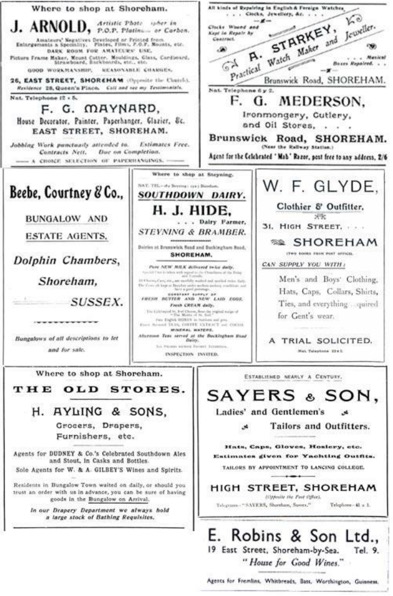
All Photos in this article are from the collections of Doris Steers, Peggy McCulloch and John Lucking
Roger Bateman & Gerald White August 2009

